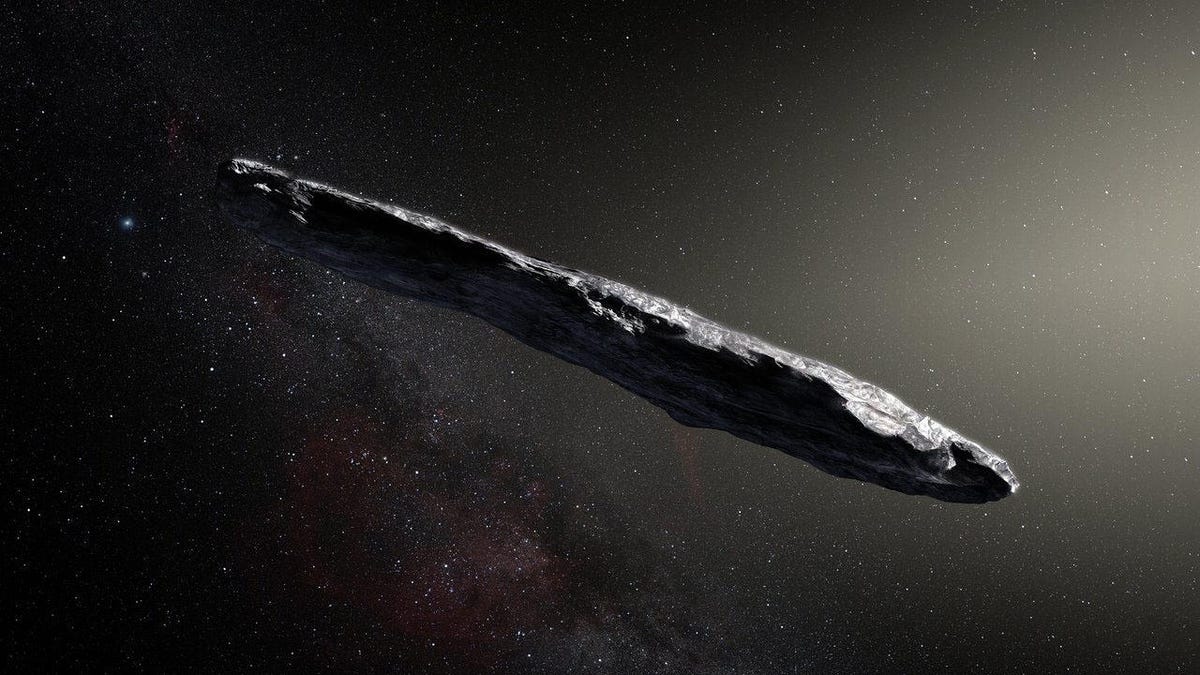NASA reveals new findings about 'Oumuamua, the 'alien probe' asteroid
The Spitzer telescope looked for 'Oumuamua and couldn't find it -- but that doesn't mean it was sent by an alien civilization.

There have been some zany theories about the cigar-shaped asteroid, known as 'Oumuamua, that scientists first detected zipping through our solar system in October 2017.
As the first interstellar object we've detected floating through our neck of the cosmic woods, 'Oumuamua captivated scientists and stargazers alike. Its detection was a watershed moment because, although scientists suspect interstellar visitors pass through our system with some regularity, this was the first time they had actually seen one.
The unusual shape and strange speed of the interstellar asteroid had astronomers puzzled. It seemed to zip past the sun in a way scientists did not expect, grabbing an unexpected speed boost on its journey across the solar system. That led to one particular paper suggesting it might even be an alien probe, sent from the far reaches of space.
Immediately after its detection, ground-based and space-based telescopes focused themselves on 'Oumuamua, hoping to understand exactly what it was.
One of those telescopes was Spitzer, an infra-red telescope NASA launched in 2003. In a study published on Wednesday in The Astronomical Journal, astronomers explained that they pointed Spitzer at 'Oumuamua for two months after its initial detection but they couldn't detect it.
"The fact that 'Oumuamua was too small for Spitzer to detect is actually a very valuable result," said David Trilling, lead author on the paper.
Though it seems like a "non-detection" might not be able to tell us anything about 'Oumuamua, it's actually quite an important finding because it places constraints on just how strange an object the interstellar visitor can be.
Astronomers suspect jets of gas are responsible for giving 'Oumuamua an unusual speed boost.
The Spitzer telescope has a different pair of eyes to a traditional telescope, as it were, because it sees in infrared energy and thus detects a heat signature, rather than looking for reflected light. Though it is believed that 'Oumuamua has an elongated body, Spitzer cannot infer the shape of the object from its reading, but can make an estimate about the object's "spherical diameter". The study suggests it may be as small as 100 meters (320 feet), or as large as 440 meters (1,440 feet).
Importantly, placing size constraints on 'Oumuamua is central to one of the outstanding mysteries of the interstellar visitor -- the unusual speed boost it received as it sped past the sun. In June, a study suggested that if the asteroid was small enough, outgassing -- the release of gas trapped in the asteroid as it heats up -- may be responsible for the increased speed. Spitzer's observations certainly make that theory much more likely and effectively puts the "alien probe" theory to bed.
As the object continues its journey through space, away from the Earth, it gets further and further away from our telescopes so we're unlikely to get a handle on just exactly what 'Oumuamua is.
Like ships in the night, the Earth and 'Oumuamua are destined to carry on sailing across the cosmic ocean, never to meet again.
CNET's Holiday Gift Guide: The place to find the best tech gifts for 2018.
Best Black Friday 2018 deals: The best discounts we've found so far.

